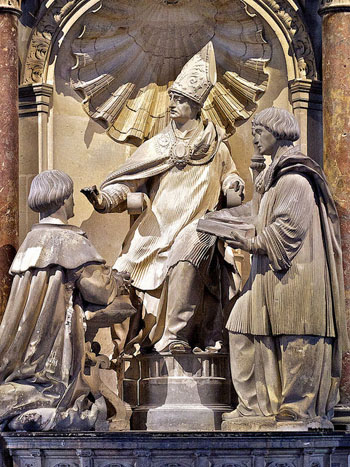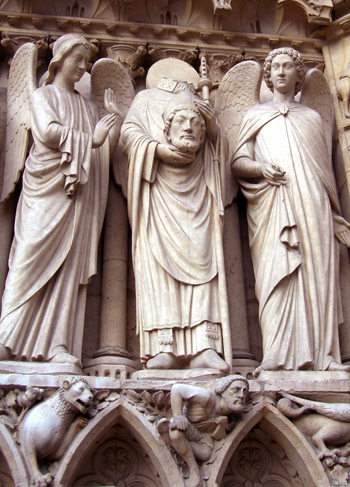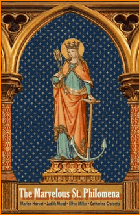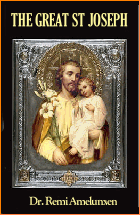Symbolism
 |
 |
 |
 |
 |
 |
 |
Local Saints Come First
After the Apostles, it is not easy to say which saints were preferred in the Middle Ages, or what motives led to the representation of one saint rather than another. What idea dominated the choice of the hosts of legends seen in the stained glass windows at Tours, Le Mans, Chartres, Bourges? And why, for instance, does one so often meet the story of St. Nicholas? In spite of scholarly research there will always be mysteries in the medieval cathedral, but a partial solution may be attempted.
Works of art devoted to the saints in the 13th century may be grouped under four or five heads.
One is struck first of all by the pious wish felt in each diocese to do honor to its local saints. After the Apostles, the local saints hold the foremost place in the churches, and a whole porch is often devoted to their lives, miracles and death.
The religious history of Picardy is written large in the left porch of the great façade at Amiens. On the lintel is St. Firmin, who brought the Faith to the ancient Samarobriva of the Ambiani. Around him is his guard of honor: St. Gentien, St. Fuscien and St. Victoric, the first martyrs; St. Honoré and St. Salvius, the first Bishops; St. Domice, St. Geoffroy and the virgin St. Ulphia, the most famous saint of the Diocese. In the tympanum is seen the story of the relics of St. Firmin and of the miraculous passage of his shrine, and in the south porch is a detailed representation of the chief features of the life of St. Honoré, Amiens' greatest Bishop.
 In the same way one of the north porches at Reims shows the saints of the province. Like St. Firmin at Amiens, St. Sixtus has the foremost place at Reims, for it was he who brought the Gospel to Champagne. On either side of him are his successors - martyrs or illustrious bishops: St. Nicasius who was massacred by the Vandals on the threshold of his church and left the stain of his blood on a stone, his sister, St. Eutropia, who was killed while defending him, and St. Remigius who received the sacred oil brought by a celestial dove.
In the same way one of the north porches at Reims shows the saints of the province. Like St. Firmin at Amiens, St. Sixtus has the foremost place at Reims, for it was he who brought the Gospel to Champagne. On either side of him are his successors - martyrs or illustrious bishops: St. Nicasius who was massacred by the Vandals on the threshold of his church and left the stain of his blood on a stone, his sister, St. Eutropia, who was killed while defending him, and St. Remigius who received the sacred oil brought by a celestial dove.
The memory of St. Remi was so intimately associated with the coronation church Reims Cathedral that art could not fail to tell his history to the inhabitant of Reims, and his story with its principal miracles are seen in delightful bas-reliefs in the tympanum of the north porch.
Two of the five porches of the Cathedral of Bourges are dedicated to the saints of the district. The right porch recalls the memory of St. Ursin, the Apostle of Berri and the Bourbonnais; the left, the memory of St. Guillaume, the Bishop famed for his miracles and for his victories over the Devil.
The statues in these two porches were mutilated by the Protestants, but they no doubt represented the canonised Bishops of the church of Bourges, St. Oustrille and St. Sulpice, in a word, those whose images accompany the figures of the Apostles in the nave windows.
 Although at Notre Dame at Paris no porch was entirely devoted to the images of the saints of the Île-de-France, several large statues and a few remarkable bas- reliefs made it impossible for the people of Paris to forget St. Denis, the Bishop of Paris who was martyred by being beheaded by a sword on the highest hill in Paris (today Montmartre). After his head was chopped off, Denis picked it up and walked to the bottom of the hill, preaching a sermon the entire way. The site where he stopped preaching and died was marked by a small shrine that became St. Denis Basilica, which became the burial place for the Kings of France.
Although at Notre Dame at Paris no porch was entirely devoted to the images of the saints of the Île-de-France, several large statues and a few remarkable bas- reliefs made it impossible for the people of Paris to forget St. Denis, the Bishop of Paris who was martyred by being beheaded by a sword on the highest hill in Paris (today Montmartre). After his head was chopped off, Denis picked it up and walked to the bottom of the hill, preaching a sermon the entire way. The site where he stopped preaching and died was marked by a small shrine that became St. Denis Basilica, which became the burial place for the Kings of France.
Nor does Notre Dame forget her beloved St. Geneviève and, above all, St. Marcel. On the pierglass in the early Portail Sainte-Anne, the famous Bishop of Paris is seen piercing the dragon with his crosier, and round the arch of the Portail Rouge, which is at least a century later, part of his legend, and in particular his contest with the cemetery vampire, is told in groups of exquisite workmanship.
At Chartres windows and statuary rival one another in celebrating the first confessors of the Faith in the country of the Carnutes. There is St. Potentian, a 4th century martyr who was killed with an axe at the spot now occupied by the crypt of a church in Sens dedicated to the saint; St. Modeste, daughter of the Roman governor Quirinus, who was thrown by her father into a well with other martyrs; St. Chéron who, like St. Denis, carries his head; St. Lubin the herdsman who became Bishop of Chartres, and St. Laumer, monk of the forest of La Perche.
It was the same in all the cathedrals. In many mutilated churches that have lost the greater number of their statues and windows, there yet remain more than a few monuments of their first bishops or martyrs.
From these great monuments the people gained some slight idea of their history, and became conscious that they too had their patrons who were firmly rooted in the soil. Each cathedral grew up like an indigenous plant that owes its color and perfume to its native earth.

Works of art devoted to the saints in the 13th century may be grouped under four or five heads.
One is struck first of all by the pious wish felt in each diocese to do honor to its local saints. After the Apostles, the local saints hold the foremost place in the churches, and a whole porch is often devoted to their lives, miracles and death.
The religious history of Picardy is written large in the left porch of the great façade at Amiens. On the lintel is St. Firmin, who brought the Faith to the ancient Samarobriva of the Ambiani. Around him is his guard of honor: St. Gentien, St. Fuscien and St. Victoric, the first martyrs; St. Honoré and St. Salvius, the first Bishops; St. Domice, St. Geoffroy and the virgin St. Ulphia, the most famous saint of the Diocese. In the tympanum is seen the story of the relics of St. Firmin and of the miraculous passage of his shrine, and in the south porch is a detailed representation of the chief features of the life of St. Honoré, Amiens' greatest Bishop.

A sculpture of St. Remigius baptizing Clovis depicted in the Cathedral of Reims
The memory of St. Remi was so intimately associated with the coronation church Reims Cathedral that art could not fail to tell his history to the inhabitant of Reims, and his story with its principal miracles are seen in delightful bas-reliefs in the tympanum of the north porch.
Two of the five porches of the Cathedral of Bourges are dedicated to the saints of the district. The right porch recalls the memory of St. Ursin, the Apostle of Berri and the Bourbonnais; the left, the memory of St. Guillaume, the Bishop famed for his miracles and for his victories over the Devil.
The statues in these two porches were mutilated by the Protestants, but they no doubt represented the canonised Bishops of the church of Bourges, St. Oustrille and St. Sulpice, in a word, those whose images accompany the figures of the Apostles in the nave windows.

The story of St. Denis carrying his head, represented at Notre Dame Cathedral in Paris
Nor does Notre Dame forget her beloved St. Geneviève and, above all, St. Marcel. On the pierglass in the early Portail Sainte-Anne, the famous Bishop of Paris is seen piercing the dragon with his crosier, and round the arch of the Portail Rouge, which is at least a century later, part of his legend, and in particular his contest with the cemetery vampire, is told in groups of exquisite workmanship.
At Chartres windows and statuary rival one another in celebrating the first confessors of the Faith in the country of the Carnutes. There is St. Potentian, a 4th century martyr who was killed with an axe at the spot now occupied by the crypt of a church in Sens dedicated to the saint; St. Modeste, daughter of the Roman governor Quirinus, who was thrown by her father into a well with other martyrs; St. Chéron who, like St. Denis, carries his head; St. Lubin the herdsman who became Bishop of Chartres, and St. Laumer, monk of the forest of La Perche.
It was the same in all the cathedrals. In many mutilated churches that have lost the greater number of their statues and windows, there yet remain more than a few monuments of their first bishops or martyrs.
From these great monuments the people gained some slight idea of their history, and became conscious that they too had their patrons who were firmly rooted in the soil. Each cathedral grew up like an indigenous plant that owes its color and perfume to its native earth.

Selected from Emile Mâle,
The Gothic Image: Religious Art in France of the 13th Century.
NY: Harper & Brothers, pp 310-315
Posted October 11, 2014
The Gothic Image: Religious Art in France of the 13th Century.
NY: Harper & Brothers, pp 310-315
Posted October 11, 2014
______________________
______________________











